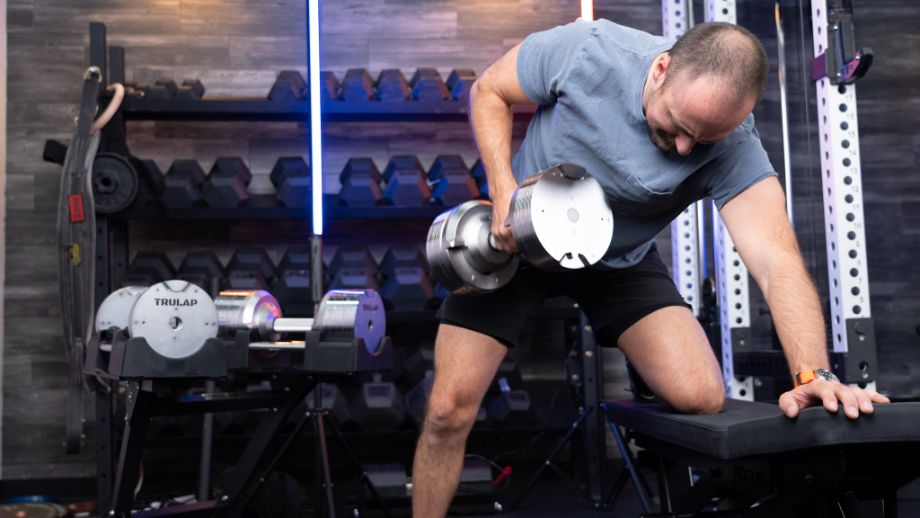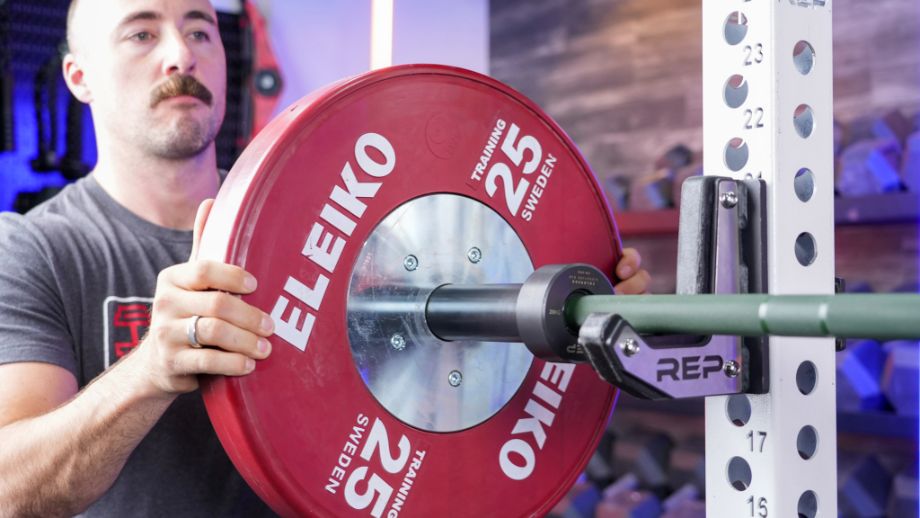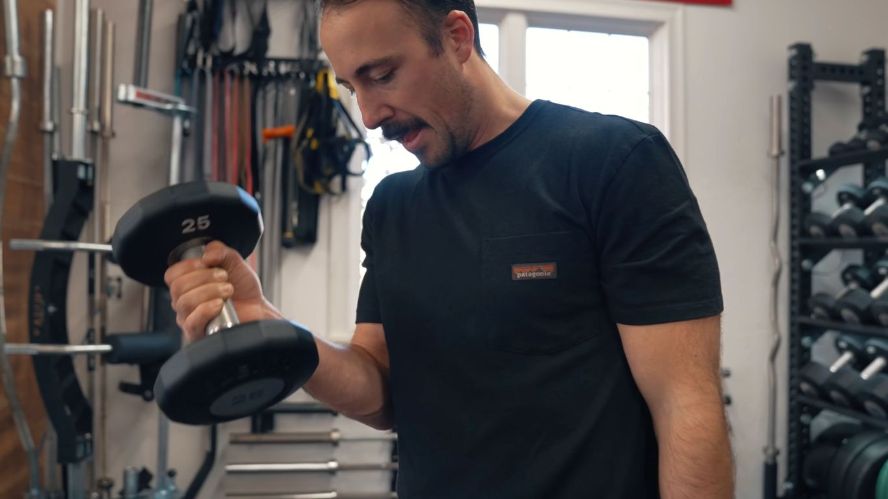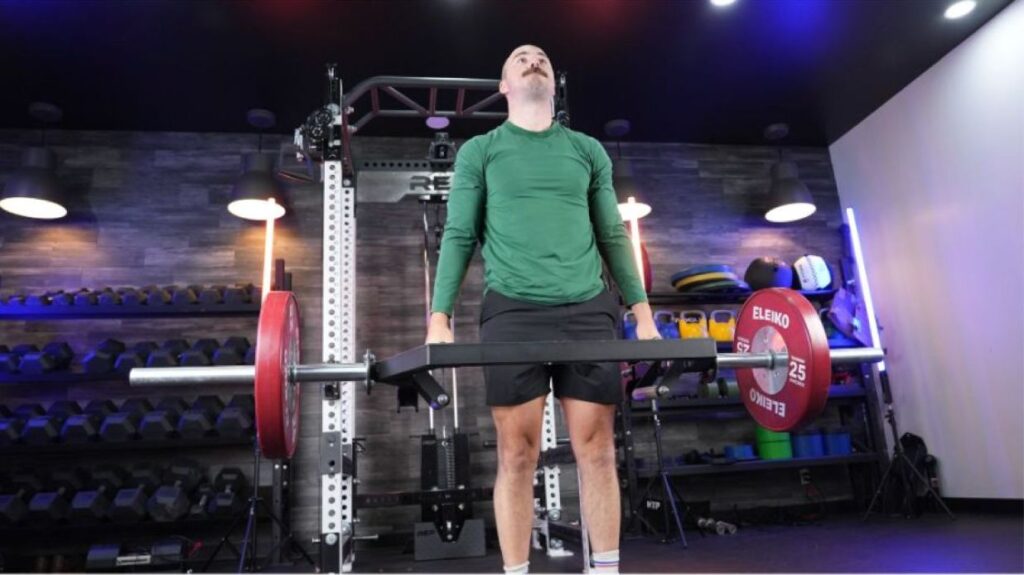We test and review fitness products based on an independent, multi-point methodology. If you use our links to purchase something, we may earn a commission. Read our disclosures.
Building muscle mass is a common gym goal. You’d think grinding it out on the reg and consuming high-protein foods for muscle building would be enough to get results, yet fitness enthusiasts everywhere wind up frustrated after weeks of dedication and nothing to show.
It takes a little more than just a few sets of strength training exercises to achieve the type of hypertrophy you’d see in a bodybuilding competition. There’s a science to it.
RELATED: Bodybuilding Workouts
Today, we’re diving into that science and discussing what goes into an effective hypertrophy training regimen with Dr. Michael Masi, DPT, SCS, CSCS, CISSN, USAW-1, and owner of Masi Fitness. We’ve also put together a hypertrophy workout that’ll help you build a bigger, badder physique.
What Is Hypertrophy?
The National Academy of Sports Medicine1 (NASM) defines hypertrophy as “the enlargement of skeletal muscle fibers in response to being recruited to develop increased levels of tension.”
Another definition comes from Acta Physiologica2, which considers hypertrophy “an increase in total mass of a muscle.”
Any muscle size increase, whether caused intentionally during a hypertrophy-based resistance training program or as a byproduct of other fitness activities, is considered muscle hypertrophy.

How To Stimulate Hypertrophy
So, why does hypertrophy happen, and how do we reliably stimulate it to get those big gains we’ve been chasing?
RELATED: How Many Reps to Build Muscle
According to a 2019 study published in the International Journal of Environmental Research and Public Health3, “muscle hypertrophy occurs when muscle protein synthesis exceeds muscle protein breakdown and results in positive net protein balance in cumulative periods.”
Basically, exercise causes damage to the fibers of your muscles. You need to allow for a process called “protein synthesis4” to repair the damage before targeting those muscles again. Once protein synthesis occurs and repairs the exercise-related trauma to your muscle fibers, it takes things a step further and leads to “muscle adaptation.”
“Muscle adaptations are your body’s response to the muscle damage,” says Dr. Masi. “If you’ve done the right amount of work, allowed the right amount of rest, and ingested the right amount of protein, your muscles will adapt to become bigger and stronger.”
RELATED: How to Get More Protein
How to Train for Hypertrophy
Achieving muscular hypertrophy is about balancing various factors. Here are the most important when creating a workout program designed for hypertrophy.
Total Training Volume
Volume is one of the most important factors to consider, but most people assume that “more is more” when it comes to building big muscles. That’s not inherently true.
“There’s this thing called the ‘strength-recovery adaptation curve’ that describes the body’s response to exercise-induced trauma5,” says Dr. Masi, DPT, SCS, CSCS, CISSN, USAW-1. “Exercise fatigues the muscles, which requires recovery, which leads to repair and supercompensation and, as a result, ultimately leading in hypertrophy.”
So long as you’re only fatiguing the muscles to a point in which they can recover completely and then some, you’ll receive a size gain as a result of overcompensation. That is to say the muscle wants to be ready for future exercise-induced trauma, so the body rebuilds it to be bigger and stronger.
If you cause too much damage, however, you won’t effectively recover through protein synthesis, and your gains will be diminished; so, it’s about getting the workload just right to maximize muscle gains without overdoing it.
RELATED: Best Muscle Recovery Supplements

Reps and Sets
So, what’s the magic number of reps and sets that will provide the right amount of total training volume without eating into those precious gains?
NASM1 recommends “performing approximately 15-20 sets of challenging hypertrophy exercises per week is the optimum stimulus to enhance muscle size” or “5-6 sets of a specific exercise” for each major muscle group spread over the course of a week.
The American College of Sports Medicine3 (ACSM), likewise, “recommends 1−3 sets per exercise of 8−12 repetitions with 70−85% of one-repetition maximum (1RM) for novice and 3−6 sets of 1−12 repetitions with 70−100% 1RM for advanced individuals.”
We recommend—based on the evidence-based research and our own professional experience—performing about 3 to 6 sets of 8 to 12 reps, lifting approximately 75% of your one-rep max.
Time Under Tension
Increasing the time under tension is another method of maximizing hypertrophy.
A 2012 study published in The Journal of Physiology6 found that slower reps, six seconds during the concentric phase and six seconds during the eccentric phase, produced “greater increases in rates of muscle protein synthesis” and “may be important in optimizing muscle growth.”
Spending twelve seconds per rep will seriously increase the total amount of time you’re in the gym, making it less feasible for those who need to keep their workouts to a tight sixty minutes.
So, if you’re going to get the most bang for your buck, try taking your time on the eccentric phase rather than the concentric phase, as studies show7 that “the mean percent change in muscle growth…[favors] eccentric compared with concentric actions.”
RELATED: Eccentric Training
Muscle Force/Loading

As any seasoned fitness aficionado knows, not all exercises are created equal; that is to say, not all exercises create the same level of damage to the muscle fibers.
Performing a barbell bench press using heavy weights, for example, will produce more damage to the fibers than a set of bodyweight push-ups, thus requiring more recovery time. However, high-damage exercises are also known to create a stronger muscle adaptation, which is conducive to the goal of achieving hypertrophy.
“For strength, we want to lift heavy and really push the envelope,” says Dr. Masi, DPT, SCS, CSCS, CISSN, USAW-1. “That’s not the same with hypertrophy programs. For muscle gain, we want to keep the load moderate, no greater than 85% of your one-rep max, and lift within the 8 to 12-rep range.”
Cadence and Tempo
Cadence and tempo refer to the rhythm at which you’re lifting.
RELATED: How And Why You Should Do Tempo Training
A standard cadence is generally two seconds during the concentric phase, zero seconds at the peak position, and two seconds during the eccentric phase. So, you lift, hit the top, and come straight back down. Enough said.
Working with a different cadence or varying the tempo means increasing the amount of time during each phase and increasing the time under tension, too.
You could keep things consistent—as the aforementioned 2012 Journal of Physiology study6 shows—extending both exercise phases to six seconds each, or you may vary the tempo, moving quickly through the concentric phase and then slowly moving through the eccentric, for example.
According to a 2021 study published in Sports Medicine8, “the most favorable is a combination of slower movement in the eccentric phase with a faster movement during the concentric phase” when it comes to hypertrophy.
There’s nothing necessarily wrong with the standard two-seconds up, two-seconds down rhythm, but taking your time on the eccentric phase—a maximum of six seconds, if possible—could contribute to better overall hypertrophic gains.

Progressive Overload
“Remember—muscle strength and size go hand-in-hand,” says Dr. Masi, DPT, SCS, CSCS, CISSN, USAW-1.. “Just because we’re structuring our weight training for hypertrophy doesn’t mean we won’t make strength gains, too.”
As your strength increases, you’ll need to lift progressively heavier weights to stay within the optimal 75% to 85% one-rep max range. Otherwise, your body will become accustomed to the same stimulus week after week, and you’ll plateau.
RELATED: What Is Progressive Overload?
So, don’t be afraid to mix in a little strength training, using low rep schemes with weights that approach your actual one-rep max. Doing so will help you establish how much you should be lifting the rest of the time in order to stay within the threshold where hypertrophy is maximized.
A certified personal trainer or qualified coach should be able to tell you specifically when a one-rep max test is in order.
Rest Intervals
The final factor to keep in mind is the rest interval. Again, it’s all about balance, as resting too little doesn’t properly prepare you for the next set, while taking way too much time lets your muscles cool off, negatively impacting your performance.
For maximum hypertrophy, rest approximately 30 to 60 seconds between sets.
How Long Does It Take to Build Muscle?
Unfortunately, it’s difficult to pinpoint the precise amount of time it will take to realize significant gains in muscle size.
And, as with all things fitness, the results will vary depending on numerous variables, including the age and fitness level of the individual, their diet, the amount of sleep they’re getting, and more.
RELATED: How to Build Muscle
“I urge new clients and beginners to trust the process and stay committed for at least eight weeks,” says Dr. Masi. “Combining your resistance training program with a great diet and eight hours of sleep each night helps expedite the process, but it can take some time.”

That said, some studies9 observed increases in muscle thickness after as little as one week of training, so it’s not impossible to make strides right out the gate.
The most crucial aspect when endeavoring to build muscle, however, is consistency. You’ll constantly fluctuate if your schedule is sporadic, so commit to a plan, work the plan, and let the results follow.
Hypertrophy Workout Plan
Strength training programs involve low rep schemes and lifting super heavy weights, while exercise programs revolving around weight loss and endurance building are more apt to use ample cardio and compound exercises for a full-body workout that torches calories.
That’s not the goal with a hypertrophy training program, so we need a workout split that targets a select few muscle groups effectively and then leaves them be for approximately 48 hours.
“The best workout split I’ve found involves alternating between upper body and lower body exercises each day,” says Dr. Masi, DPT, SCS, CSCS, CISSN, USAW-1, and owner of Masi Fitness. “Alternating between using pushing muscles, like the chest, triceps, and quadriceps, and pulling muscles, like the biceps, lats, and hamstrings, is also very effective.”
RELATED: Full-Body Workout Vs Split
For that reason, we use the upper-body pushing muscles on the first day, lower-body pushing muscles on the second, upper-body pulling muscles on the third, and lower-body pulling muscles on the last.
One Week of Hypertrophy Workouts: Sample Workout Plan
So, enough with the science already! What’s that workout plan look like?
“Our hypertrophy program involves a 4-day split, targeting each major muscle group while allowing proper recovery time for each,” says Dr. Masi, DPT, SCS, CSCS, CISSN, USAW-1. “Remember to use moderate weight, about 75% to 85% your one-rep max, and aim to take only a minute between sets and exercises.”

Without further ado, the workout!
Session 1: Upper Push (Chest, Tris, and Shoulders)
| Exercise | Sets | Reps |
| Incline Barbell Bench Press | 3 to 6 | 8 to 12 |
| Flat Dumbbell Chest Fly | 3 to 6 | 8 to 12 |
| Barbell Military Press | 3 to 6 | 8 to 12 |
| Cable Face Pulls | 3 to 6 | 8 to 12 |
| Front and Lateral Raise | 3 to 6 supersets | 8 to 12 |
RELATED: Superset Workouts
Session 2: Legs Anterior Focus (Quads)
| Exercise | Sets | Reps |
| Barbell Back Squat | 3 to 6 | 8 to 12 |
| Walking Lunge | 3 to 6 | 8 to 12 |
| Leg Press | 3 to 6 | 8 to 12 |
| Leg Extension | 3 to 6 | 8 to 12 |
Session 3: Upper Pull (Back and Bis)
| Exercise | Sets | Reps |
| Bent-Over Barbell Row | 3 to 6 | 8 to 12 |
| Dumbbell Biceps Curl | 3 to 6 | 8 to 12 |
| Lat Pulldown | 3 to 6 | 8 to 12 |
| Rear Delt Fly | 3 to 6 | 8 to 12 |
| Cable Biceps Curl | 3 to 6 | 8 to 12 |
Session 4: Legs Posterior Focus (Glutes, Hamstrings, Calves)
| Exercise | Sets | Reps |
| Romanian Deadlift | 3 to 6 | 8 to 12 |
| Bulgarian Split Squat | 3 to 6 | 8 to 12 |
| Leg Curl | 3 to 6 | 8 to 12 |
| Reverse Lunge | 3 to 6 | 8 to 12 |
| Seated Calf Raise | 3 to 6 | 8 to 12 |
Hypertrophy Workout: Final Thoughts
It’s easy to get discouraged when you’ve been giving it your all and coming up short.
Don’t let it ruin your drive! With a few adjustments to your approach and the recommendations found in this guide, you can be well on your way to making gains as soon as next week!
Give our hypertrophy workout a try, and, as always, good luck out there, fitness fam!
Hypertrophy Workout: FAQs
How can I build muscle faster?
Unfortunately, there are no shortcuts to hard work. Building muscle requires weeks of resistance training, clean eating, proper resting, and consistency.
There are some supplements for muscle growth that may help speed things along, but otherwise it’s all about the lifestyle, including what you do in and outside the gym.
How many days per week to workout to build muscle?
A typical muscle-building workout split features four days of training and three days of rest, but you aren’t required to rest completely on those days. Your off days could be spent doing “active rest” in the form of light cardio, playing sports, yoga, Pilates, or other physical activities that won’t otherwise interfere with the hypertrophy plan.
RELATED: Pilates Workout
We only recommend that you don’t go too hard on the non-training days, as it could interfere with your performance when it matters most, and that you do leave at least one day where you truly rest and relax.
Everyone needs a break sometimes.
What exercises should I do for hypertrophy?
Our hypertrophy workout mixes some compound exercises, like the bench press, with isolation exercises, like front and lateral raises, so that every major muscle group is given its due.
But the specific exercises matter less than how they are performed. For hypertrophy, do not exceed 85% your one-rep max and stick to a moderate 8 to 12 rep scheme. Deviating from that could diminish your overall hypertrophic gains.
References
1. Adams, A. (n.d.). Muscular hypertrophy: Back to the basics [updated July 2022]. NASM. https://blog.nasm.org/sports-performance/back-to-the-basics-hypertrophy
2. Boonyarom O, Inui K. Atrophy and hypertrophy of skeletal muscles: structural and functional aspects. Acta Physiol (Oxf). 2006;188(2):77-89. doi:10.1111/j.1748-1716.2006.01613.x
3. Krzysztofik M, Wilk M, Wojdała G, Gołaś A. Maximizing Muscle Hypertrophy: A Systematic Review of Advanced Resistance Training Techniques and Methods. Int J Environ Res Public Health. 2019;16(24):4897. Published 2019 Dec 4. doi:10.3390/ijerph16244897
4. Witard OC, Bannock L, Tipton KD. Making Sense of Muscle Protein Synthesis: A Focus on Muscle Growth During Resistance Training. Int J Sport Nutr Exerc Metab. 2022;32(1):49-61. doi:10.1123/ijsnem.2021-0139
5. Clarkson PM, Hubal MJ. Exercise-induced muscle damage in humans. Am J Phys Med Rehabil. 2002 Nov;81(11 Suppl):S52-69. doi: 10.1097/00002060-200211001-00007. PMID: 12409811.
6. Burd NA, Andrews RJ, West DW, et al. Muscle time under tension during resistance exercise stimulates differential muscle protein sub-fractional synthetic responses in men. J Physiol. 2012;590(2):351-362. doi:10.1113/jphysiol.2011.221200
7. Schoenfeld BJ, Ogborn DI, Vigotsky AD, Franchi MV, Krieger JW. Hypertrophic Effects of Concentric vs. Eccentric Muscle Actions: A Systematic Review and Meta-analysis. J Strength Cond Res. 2017;31(9):2599-2608. doi:10.1519/JSC.0000000000001983
8. Wilk M, Zajac A, Tufano JJ. The Influence of Movement Tempo During Resistance Training on Muscular Strength and Hypertrophy Responses: A Review. Sports Med. 2021;51(8):1629-1650. doi:10.1007/s40279-021-01465-2
9. Loenneke JP, Rossow LM, Fahs CA, Thiebaud RS, Grant Mouser J, Bemben MG. Time-course of muscle growth, and its relationship with muscle strength in both young and older women. Geriatr Gerontol Int. 2017;17(11):2000-2007. doi:10.1111/ggi.13010
Further reading

Our experts found the best supplements for muscle growth, including protein powder, creatine supplements, mass gainers, and a carb powder hand-selected by trainers. Read more

Mixing creatine and alcohol? It might not be a good idea. Here’s how creatine and alcohol affect performance, muscle-building, and more. Read more

In a comparison between treadmill vs treadclimber, a clear winner emerges between two machines that look deceivingly similar. Read more

Looking for a high-value air bike? Our Fringe Sport Raptor Air Bike review looks at one of the latest machines to hit the market. Read more

